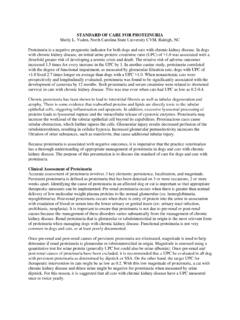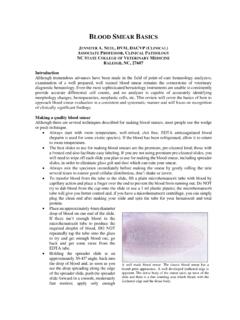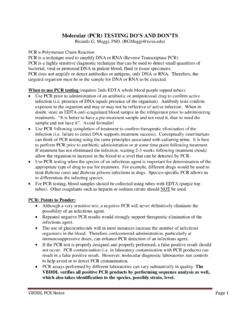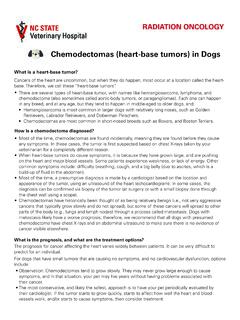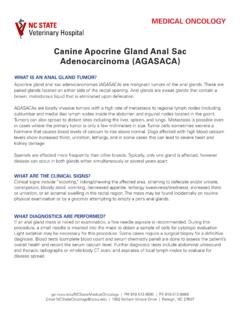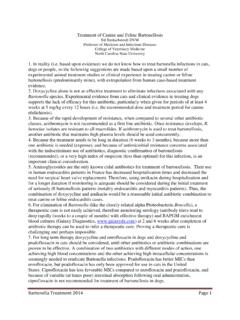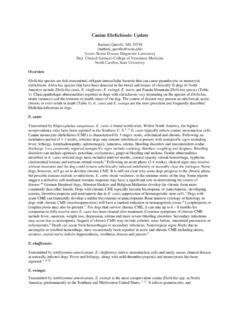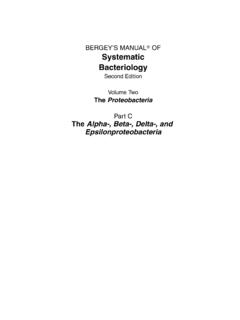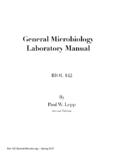Transcription of INFECTIOUS ORGANISMS OF OPHTHALMIC IMPORTANCE …
1 INFECTIOUS ORGANISMS OF OPHTHALMIC IMPORTANCE Diane VH Hendrix, DVM, DACVO University of Tennessee, College of Veterinary Medicine, Knoxville, TN 37996 OCULAR bacteriology Bacteria are prokaryotic ORGANISMS consisting of a cell membrane, cytoplasm, RNA, DNA, often a cell wall, and sometimes specialized surface structures such as capsules or pili. Bacteria lack a nuclear membrane and mitotic apparatus. The DNA of most bacteria is organized into a single circular chromosome. Additionally, the bacterial cytoplasm may contain smaller molecules of DNA plasmids that carry information for drug resistance or code for toxins that can affect host cellular functions. Some physical characteristics of bacteria are variable. Mycoplasma lack a rigid cell wall, and some agents such as Borrelia and Leptospira have flexible, thin walls.
2 Pili are short, hair-like extensions at the cell membrane of some bacteria that mediate adhesion to specific surfaces. While fimbriae or pili aid in initial colonization of the host, they may also increase susceptibility of bacteria to phagocytosis. Bacteria reproduce by asexual binary fission. The bacterial growth cycle in a rate-limiting, closed environment or culture typically consists of four phases: lag phase, logarithmic growth phase, stationary growth phase, and decline phase. Iron is essential; its availability affects bacterial growth and can influence the nature of a bacterial infection. The fact that the eye is iron-deficient may aid in its resistance to bacteria. Bacteria that are considered to be nonpathogenic or weakly pathogenic can cause infection in compromised hosts or present as co-infections.
3 Some examples of opportunistic bacteria include Staphylococcus epidermidis, Bacillus spp., Corynebacterium spp., Escherichia coli, Klebsiella spp., Enterobacter spp., Serratia spp., and Pseudomonas spp. (other than Pseudomonas aeruginosa, depending on whose research you read). The infectivity of pathogenic microorganisms is influenced by their ability to initiate the INFECTIOUS process. Bacterial adhesion to epithelial cells is a critical initial step. Adhesins, which are protein determinates of adherence, have been identified for most bacterial pathogens. Some adhesins are expressed in bacterial pili. Additionally, production of virulent factors increases the ability of an organism to cause tissue inflammation and destruction. Virulent factors include proteases, elastases, hemolysins, and cytoxins.
4 Among the bacteria of the most interest in ocular bacteriology are Pseudomonas aeruginosa and Moraxella bovis. While differences between species do exist, bacterial keratitis is the most common and dangerous OPHTHALMIC manifestation of bacterial disease in most species. Typically, the epithelium provides a crucial barrier to infection, and its integrity requires efficient wound healing. Bacterial cells and secretomes from a subset of species of bacteria inhibited human and porcine corneal epithelial cell migration in vitro and ex vivo. Secretomes from 71% of Pseudomonas aeruginosa and 29% of Staphylococcus aureus strains, and other bacterial species inhibited epithelial cell migration. Transposon mutagenesis implicated lipopolysaccharide (LPS) core biosynthetic genes as being required to inhibit corneal epithelial cell migration.
5 This demonstrated how bacteria impact wound healing and provided evidence that secreted LPS is a key factor in the inhibitory mechanism (Brothers 2015). Primary bacterial conjunctivitis is more common in cats than other species, whereas in dogs, bacterial conjunctivitis is usually only secondary to keratoconjunctivitis sicca. Systemic diseases such as pyometra, prostatic abscesses, and periodontal disease may result in chorioretinitis, which often goes unnoticed. Other systemic diseases such as rickettsial diseases frequently cause OPHTHALMIC signs in dogs. Normal bacterial and fungal flora Bacteria can be cultured from the conjunctival sac in 50 90% of normal dogs. Gram-positive aerobes are the most commonly cultured, with Staphylococcus spp., Bacillus spp., Corynebacterium spp., and Streptococcus spp.
6 Predominating. Gram-negative bacteria have been recovered from the conjunctival sac in 8% of normal dogs. Anaerobes are rarely isolated. The normal flora appears to vary with the season and the breed of dog. While fungi are rare, the most commonly cultured are Alternaria, Cladosporium oxysporum, Curvularia lunata, Penicillium, and Aspergillus. In one study, 11/50 dogs (22%) had a positive mycological culture from the conjunctiva from at least one eye. There was no significant effect of sex or age on frequency of fungal isolation. The presence of conjunctival fungal ORGANISMS was correlated to the presence of fungi on the skin (Verneuil 2014). We must keep in mind that we can find only what we look for. For example, anaerobes will be isolated only under the correct conditions. Also, ORGANISMS isolated by culture may represent transient environmental contaminants rather than true resident flora.
7 Conjunctival flora is altered in dogs with ulcerative keratitis. Therefore, bacteria are more likely to be isolated from the conjunctiva of dogs with ulcerative keratitis than dogs with healthy eyes. In one study, Malassezia pachydermatis, a lipophilic yeast that is most commonly associated with otitis and dermatitis, was found in 23% of eyes with corneal ulceration and only 3% of healthy eyes. The increased number of bacteria and yeast could be due to decreased ocular defenses, increased phospholipids secondary to inflammation, or due to decreased concentration of tear lysozyme from increased tear production secondary to ulceration (Prado 2004). The equine conjunctiva, like other species, has multiple types of bacteria residing as normal flora. Corynebacterium spp., beta-hemolytic Streptococcus, Staphylococcus spp.
8 , Klebsiella spp., Bacillus cereus, and Moraxella spp. have all been recovered from normal eyes of healthy horses. Unlike other species, fungi are also a common component of the normal flora of horses. Unidentifiable molds, dematiaceous molds, Chrysosporium spp., Cladosporium spp., Aspergillus spp. and Penicillium spp. are the most commonly reported isolates from normal horses; however, there may be variability depending on season, housing, and geographic location. A study from the United Kingdom showed slightly different results from those from the United States. The most frequently isolated bacterial species in the UK was Acinetobacter sp. Three genera of fungi (Mucor, Absidia and Aspergillus spp.) were isolated from 13% of horses. There was no significant effect of geographic location, sex, age, or housing on frequency of microbial isolation.
9 Horses from which Gram-negative bacteria were isolated were significantly older than horses from which Gram-positive bacteria were isolated (Johns 2011). The flora of donkeys is similar to that of horses. The fungal flora of cattle has also been studied. Cladosporium spp. and Penicillium spp. were found in the conjunctival fornix of the great majority of cattle cultured. There was no seasonal or housing difference. This might represent transient seeding from the environment, including the hay, as suspected in other species (Sgorbini 2010). Bacterial microbiota of the ocular surface of bats was described, and Staphylococcus spp. were the most frequently isolated type of microorganism from healthy bat eyes (Leigue Dos Santos 2013). Bacteria were recovered from of 46 alpaca eyes. A total of 190 bacterial isolates were cultured with a mean of 2 bacterial isolates per eye.
10 Seventy percent of isolates were Gram-positive. Staphylococcus xylosus predominated, followed by viridans streptococci and Pantoea agglomerans. Other isolated bacteria included Rothia mucilaginosa, Staphylococcus equorum, Bacillus species, Moraxella ovis, and Moraxella catarrhalis. Statistical analysis showed that alpacas harboring viridans streptococci and Moraxella species were significantly younger. Gender did not significantly affect type of bacterial isolation. There appeared to be no significant effect of age or gender on number of bacteria isolated (Storms 2016). One study investigated the bacterial and fungal flora present in the eyes of healthy and pathological chelonians and compared findings in captive bred turtles with those in tortoises. In captive breed turtles and tortoises conjunctival disease is common.

